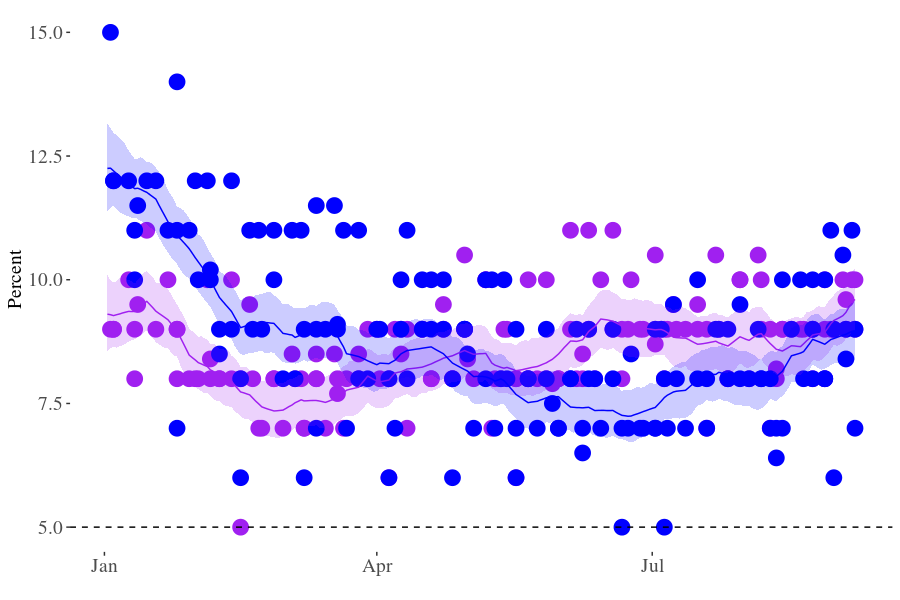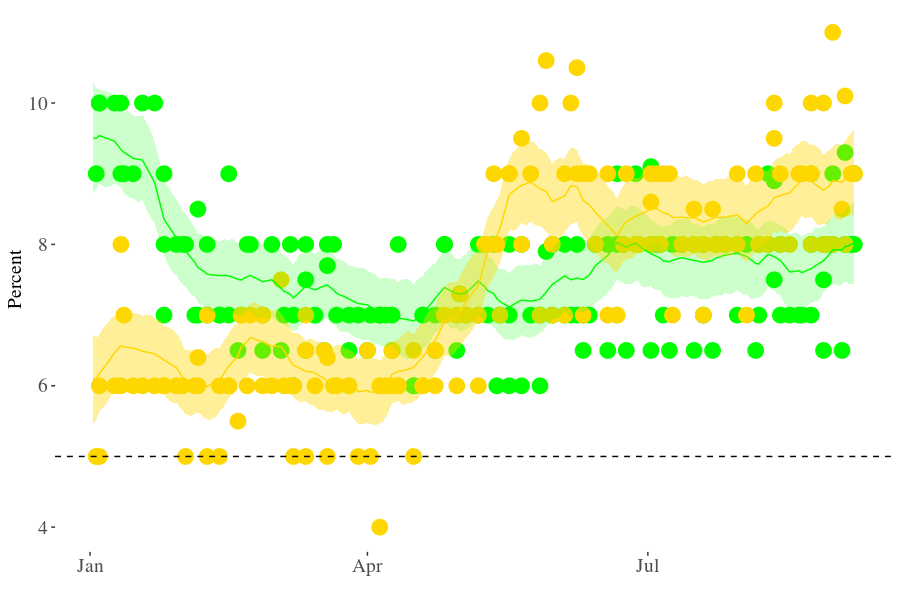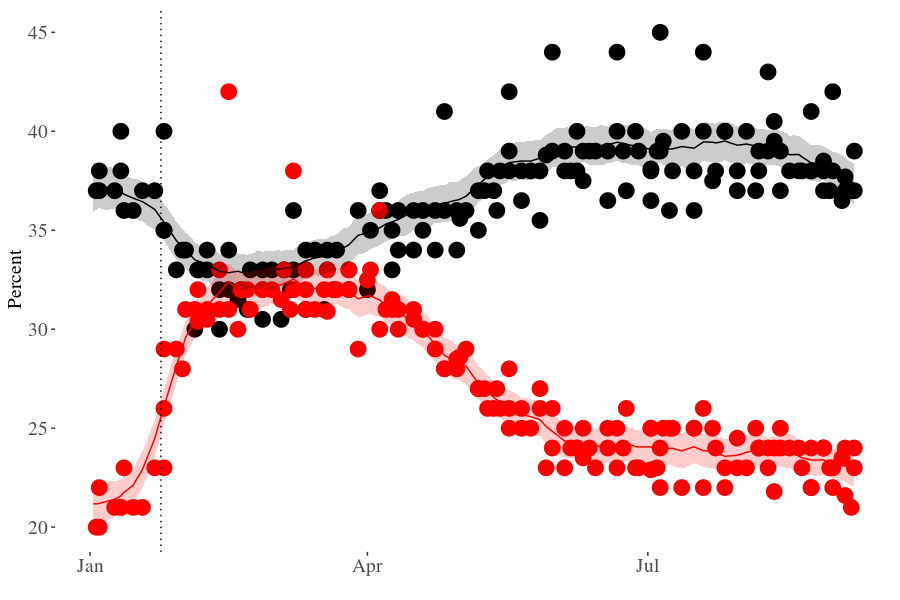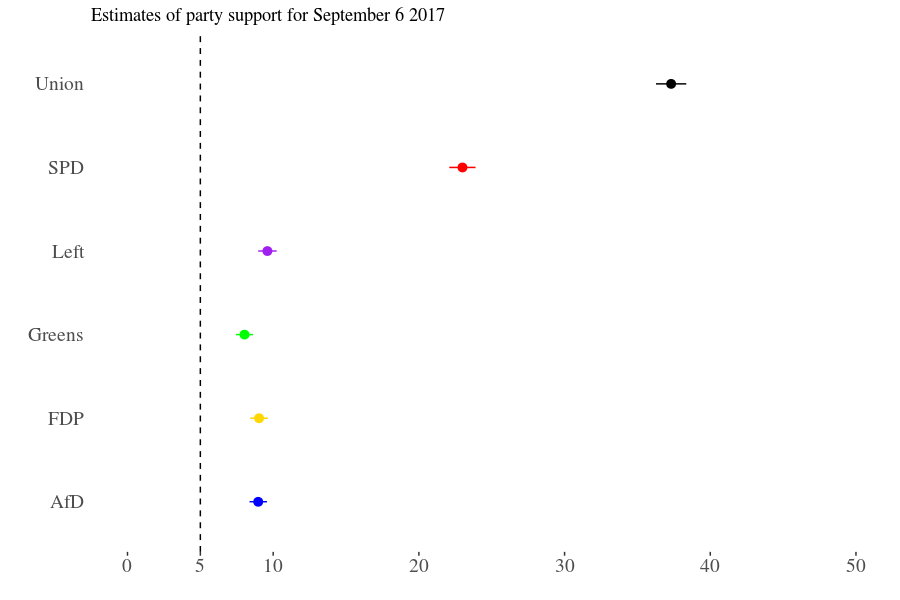With less than two weeks until the election, we now have 153 surveys from seven different companies to pore over. The bulk of these (104) were produced by Emnid, Forsa and Insa. GMS and Allensbach have delivered only a handful of polls (seven and nine, respectively), while FGW (15) and Dimap (18) occupy the middle ground. Although this is the so-called “hot phase” of the campaign, with TV debates, tours of the country and whatnot, there is still very little movement in the (averaged) results. Unless my model is filtering out too much noise, or the polls are off, which are two entirely plausible and not mutually exclusive ideas.
The AfD and the Left are perhaps gaining some ground
Estimates for both parties have shown an upward trend for the last couple of weeks, but the gains are very moderate (a point apiece or so), and given the credible intervals, the movement is not necessarily real. But the AfD is probably doing a bit better than they did in late June, which marked their low point during the campaign.
Support for the Liberals and the Greens is mostly stable
The tiniest of declines for the major parties.
Conversely, support for the two major parties may have fallen a bit. But the credible interval for the Christian Democrats is particularly wide because there is a lot of variation in their results, whereas numbers for the SPD are all very close to the credible envelope. Spare a thought for them: It’s abundantly clear that even with their recent relative weakness, the CDU/CSU are much stronger than the Social Democrats.
Overall estimates and possible coalitions
With about a fortnight to go (polls are published with a delay, and the model assigns each poll a notional date in the middle of the actual field phase) and many postal votes already cast, the overall picture looks very much like it has for weeks now. Support for all four minor parties is virtually identical and above the electoral threshold. The SPD is hovering somewhere between 20 and 25 per cent, while the Christian Democrats are located somewhere in the high thirties.
The Guardian may daydream about a black-green coalition, but that is not very plausible at the moment: not in a single one of 60,000 simulated outcomes would such a coalition achieve a majority. Obviously, a red-green coalition is even less probable, and a red-red-green majority is out of the question, too.
Nine days ago, there was at least a chance (23%) of a traditional centre-right majority, but with the (moderate) decline in support for the Christian Democrats, this looks highly unlikely (0.1%) now. However, both a “Jamaica” coalition and a Grand coalition are feasible in all simulations. So once more, a fourth term for Merkel seems to be inevitable.





RT @kai_arzheimer: From the vault: State of the German polls: Move on, (almost) nothing to see here https://t.co/BdXQHjx2JU
State of the German polls https://t.co/S1t7fi5WJN via @kai_arzheimer
RT @kai_arzheimer: German polls:The #AfD and the Left are perhaps gaining some ground
https://t.co/c9ixbuVfsT
RT @kai_arzheimer: German polls:The #AfD and the Left are perhaps gaining some ground
https://t.co/c9ixbuVfsT
RT @kai_arzheimer: German polls:The #AfD and the Left are perhaps gaining some ground
https://t.co/c9ixbuVfsT
RT @kai_arzheimer: New blog: State of the German polls: Move on, (almost) nothing to see here https://t.co/WgHQ9xsio6 https://t.co/HOTpl6kT…
RT @kai_arzheimer: New blog: State of the German polls: Move on, (almost) nothing to see here https://t.co/WgHQ9xsio6 https://t.co/HOTpl6kT…